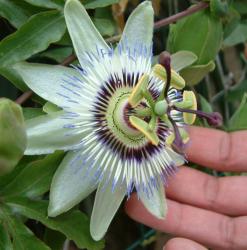Passifloraceae
Passifloraceae[edit]

The Passifloraceae is a family of flowering plants, known commonly as the passion flower family. This family is part of the order Malpighiales and includes about 27 genera and 1,000 species. The most well-known genus in this family is Passiflora, which includes the passion flowers and passion fruits.
Description[edit]
Members of the Passifloraceae family are typically herbaceous or woody vines, but they can also be shrubs or trees. The leaves are usually alternate and simple, often with a palmate or lobed shape. The flowers are often large and showy, with a complex structure that includes a corona of filaments, five sepals, five petals, and a unique arrangement of reproductive organs.
Flowers[edit]
The flowers of Passifloraceae are known for their intricate and striking appearance. They typically have a radial symmetry and are bisexual. The corona is a distinctive feature, consisting of one or more rings of thread-like structures between the petals and the stamens. The ovary is superior, and the fruit is usually a berry or capsule.
Leaves and Stems[edit]
The leaves of Passifloraceae are often lobed and may have tendrils that help the plant climb. The stems can be woody or herbaceous, depending on the species. Some species have stipules at the base of the leaf stalks.
Distribution[edit]
Passifloraceae are primarily found in tropical and subtropical regions of the world. They are especially diverse in South America, but species can also be found in North America, Africa, Asia, and Australia.
Uses[edit]
Many species in the Passifloraceae family are cultivated for their edible fruits, such as the passion fruit (Passiflora edulis). The fruits are rich in vitamins and are used in beverages, desserts, and as flavorings. Some species are also grown as ornamental plants for their attractive flowers.
Ecology[edit]
Passifloraceae plants often have complex relationships with pollinators, such as bees, butterflies, and hummingbirds. The flowers are adapted to attract specific pollinators, and some species have evolved unique mechanisms to ensure effective pollination.
Related pages[edit]
Ad. Transform your life with W8MD's Budget GLP-1 injections from $75


W8MD offers a medical weight loss program to lose weight in Philadelphia. Our physician-supervised medical weight loss provides:
- Weight loss injections in NYC (generic and brand names):
- Zepbound / Mounjaro, Wegovy / Ozempic, Saxenda
- Most insurances accepted or discounted self-pay rates. We will obtain insurance prior authorizations if needed.
- Generic GLP1 weight loss injections from $75 for the starting dose.
- Also offer prescription weight loss medications including Phentermine, Qsymia, Diethylpropion, Contrave etc.
NYC weight loss doctor appointmentsNYC weight loss doctor appointments
Start your NYC weight loss journey today at our NYC medical weight loss and Philadelphia medical weight loss clinics.
- Call 718-946-5500 to lose weight in NYC or for medical weight loss in Philadelphia 215-676-2334.
- Tags:NYC medical weight loss, Philadelphia lose weight Zepbound NYC, Budget GLP1 weight loss injections, Wegovy Philadelphia, Wegovy NYC, Philadelphia medical weight loss, Brookly weight loss and Wegovy NYC
|
WikiMD's Wellness Encyclopedia |
| Let Food Be Thy Medicine Medicine Thy Food - Hippocrates |
Medical Disclaimer: WikiMD is not a substitute for professional medical advice. The information on WikiMD is provided as an information resource only, may be incorrect, outdated or misleading, and is not to be used or relied on for any diagnostic or treatment purposes. Please consult your health care provider before making any healthcare decisions or for guidance about a specific medical condition. WikiMD expressly disclaims responsibility, and shall have no liability, for any damages, loss, injury, or liability whatsoever suffered as a result of your reliance on the information contained in this site. By visiting this site you agree to the foregoing terms and conditions, which may from time to time be changed or supplemented by WikiMD. If you do not agree to the foregoing terms and conditions, you should not enter or use this site. See full disclaimer.
Credits:Most images are courtesy of Wikimedia commons, and templates, categories Wikipedia, licensed under CC BY SA or similar.
Translate this page: - East Asian
中文,
日本,
한국어,
South Asian
हिन्दी,
தமிழ்,
తెలుగు,
Urdu,
ಕನ್ನಡ,
Southeast Asian
Indonesian,
Vietnamese,
Thai,
မြန်မာဘာသာ,
বাংলা
European
español,
Deutsch,
français,
Greek,
português do Brasil,
polski,
română,
русский,
Nederlands,
norsk,
svenska,
suomi,
Italian
Middle Eastern & African
عربى,
Turkish,
Persian,
Hebrew,
Afrikaans,
isiZulu,
Kiswahili,
Other
Bulgarian,
Hungarian,
Czech,
Swedish,
മലയാളം,
मराठी,
ਪੰਜਾਬੀ,
ગુજરાતી,
Portuguese,
Ukrainian